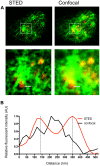New views of the human NK cell immunological synapse: recent advances enabled by super- and high-resolution imaging techniques
- PMID: 23316204
- PMCID: PMC3540402
- DOI: 10.3389/fimmu.2012.00421
New views of the human NK cell immunological synapse: recent advances enabled by super- and high-resolution imaging techniques
Abstract
Imaging technology has undergone rapid growth with the development of super resolution microscopy, which enables resolution below the diffraction barrier of light (~200 nm). In addition, new techniques for single molecule imaging are being added to the cell biologist's arsenal. Immunologists have exploited these techniques to advance understanding of NK biology, particularly that of the immune synapse. The immune synapse's relatively small size and complex architecture combined with its exquisitely controlled signaling milieu have made it a challenge to visualize. In this review we highlight and discuss new insights into NK cell immune synapse formation and regulation revealed by cutting edge imaging techniques, including super-resolution microscopy, high-resolution total internal reflection microscopy, and Förster resonance energy transfer.
Keywords: NK cell cytotoxicity; NK cell signaling; actin cytoskeleton; super-resolution microscopy; total internal reflection fluorescence microscopy.
Figures

Similar articles
-
Remodelling of cortical actin where lytic granules dock at natural killer cell immune synapses revealed by super-resolution microscopy.PLoS Biol. 2011 Sep;9(9):e1001152. doi: 10.1371/journal.pbio.1001152. Epub 2011 Sep 13. PLoS Biol. 2011. PMID: 21931537 Free PMC article.
-
High- and Super-Resolution Microscopy Imaging of the NK Cell Immunological Synapse.Methods Mol Biol. 2016;1441:141-50. doi: 10.1007/978-1-4939-3684-7_12. Methods Mol Biol. 2016. PMID: 27177663 Free PMC article.
-
Visualization of the immunological synapse by dual color time-gated stimulated emission depletion (STED) nanoscopy.J Vis Exp. 2014 Mar 24;(85):51100. doi: 10.3791/51100. J Vis Exp. 2014. PMID: 24686478 Free PMC article.
-
Recent advances in super-resolution fluorescence imaging and its applications in biology.J Genet Genomics. 2013 Dec 20;40(12):583-95. doi: 10.1016/j.jgg.2013.11.003. Epub 2013 Nov 23. J Genet Genomics. 2013. PMID: 24377865 Review.
-
Super resolution microscopy is poised to reveal new insights into the formation and maturation of dendritic spines.F1000Res. 2016 Jun 22;5:F1000 Faculty Rev-1468. doi: 10.12688/f1000research.8649.1. eCollection 2016. F1000Res. 2016. PMID: 27408691 Free PMC article. Review.
Cited by
-
Considerations of Antibody Geometric Constraints on NK Cell Antibody Dependent Cellular Cytotoxicity.Front Immunol. 2020 Jul 30;11:1635. doi: 10.3389/fimmu.2020.01635. eCollection 2020. Front Immunol. 2020. PMID: 32849559 Free PMC article. Review.
-
Live-cell imaging of receptors around postsynaptic membranes.Nat Protoc. 2014 Jan;9(1):76-89. doi: 10.1038/nprot.2013.171. Epub 2013 Dec 12. Nat Protoc. 2014. PMID: 24336472
-
The Right Partner in Crime: Unlocking the Potential of the Anti-EGFR Antibody Cetuximab via Combination With Natural Killer Cell Chartering Immunotherapeutic Strategies.Front Immunol. 2021 Sep 7;12:737311. doi: 10.3389/fimmu.2021.737311. eCollection 2021. Front Immunol. 2021. PMID: 34557197 Free PMC article. Review.
-
Engineering Anti-Tumor Monoclonal Antibodies and Fc Receptors to Enhance ADCC by Human NK Cells.Cancers (Basel). 2021 Jan 16;13(2):312. doi: 10.3390/cancers13020312. Cancers (Basel). 2021. PMID: 33467027 Free PMC article. Review.
-
MUC16 (CA125): tumor biomarker to cancer therapy, a work in progress.Mol Cancer. 2014 May 29;13:129. doi: 10.1186/1476-4598-13-129. Mol Cancer. 2014. PMID: 24886523 Free PMC article. Review.
References
-
- Axelrod D. (2001). Total internal reflection fluorescence microscopy in cell biology. Traffic 2 764–774 - PubMed
Grants and funding
LinkOut - more resources
Full Text Sources
Other Literature Sources

